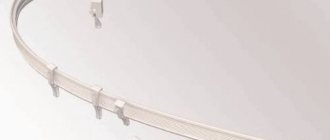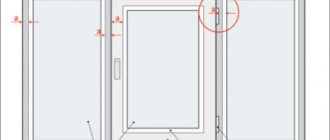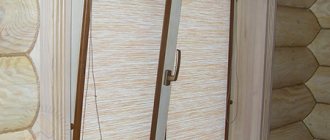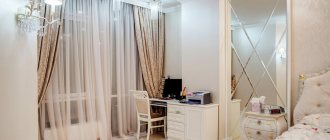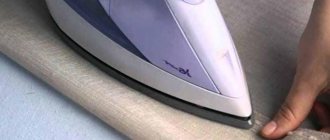How to take measurements to choose curtain size
To determine the size of curtains, first of all, you need to determine which curtain rod you will use and where this curtain rod will be located. This is important because we will take subsequent measurements from the curtain rod.
Take a tape measure and take measurements as shown in the picture. Don't forget to record all readings. Take measurements to the nearest centimeter.
- Measure the length of the curtain rod. (In fact, this will be the width of the window plus the indents on both sides of the window borders on which the cornice protrudes.) Measure the length of the cornice, within the limits - the curtain rod hangers, since the curtain fabric will not go beyond them. If you have a different type of cornice and the curtain can move along its entire length, measure the full size. Let's call this size the Working length of the cornice.
- Measure the distance from the cornice to the floor
- Measure the distance from the eaves to the top edge of the window sill
How to measure correctly
To correctly calculate the size of curtains for a window, first of all decide on the type of curtain rod and where it is attached. It is from this that the length of the curtain will be measured.
Next, using a tape measure or measuring tape, you need to measure the following indicators:
- Length of the cornice (width of the window + indents from it to the right and left). It is important to consider the presence of limiters on the crossbar. If they exist, we determine the width from one limiter to another.
- Height from cornice to floor covering.
- Height from cornice to window sill.
For more details about the measurement, see the diagram below:
How to calculate the length of curtains
Calculating the length of curtains depends on three main factors:
Select the type of curtain length you want
To choose the right curtain length, you will need to determine what type of curtains you will use in your room. The following are the main types of curtains depending on their length
- Standard long curtains , the size of this type of curtain is equal to the distance from the cornice to the floor minus 1-2 centimeters
- Extended curtains , the size of this type of curtain is equal to the distance from the cornice to the floor plus 20-30 cm.
- Short curtains , the size of this type of curtain is equal to the distance from the cornice to the top edge of the window sill
Determine the type of fastening of curtains to the cornice
Another element that affects the length of the curtains is the type of fastening of the curtain to the curtain rod.
- If you use curtain fasteners in the form of loops or hooks, then the length of the curtain should be measured taking into account the height of this fastener. In the version with loop fasteners, the total length of the curtain fabric should be reduced by the size of the loops.
- If eyelet rings are used as fasteners, then the size of the curtain fabric should be reduced by the distance of the eyelets from the top edge of the curtains.
The figure shows curtain fasteners in the form of loops and in the form of eyelet rings
Thus, the total length of the curtain will be equal to the length of the curtain fabric plus minus the length of the curtain fastening element.
Consider the length allowances for curtains
When purchasing fabric for curtains, do not forget to provide allowances of 5 cm for the top and bottom edges of the curtains for processing and hemming the edges. The top and bottom edges of the curtains must be hemmed, otherwise the curtain fabric may unravel and become “shaggy.”
Length of curtains in home areas
The traditional design of bedroom window openings is considered to be a combination of tulle and floor-length curtains. This gives the room privacy and comfort. The color scheme is selected depending on the interior.
Pastel and cold shades visually increase the space. When the window opening is located directly above the bed, it is better to select curtains up to the window sill or use roller options with the possibility of complete blackout.
The bedroom is a special place in the house where it is necessary to carefully maintain cleanliness. Long versions of curtains can be inconvenient - removing and washing them regularly is difficult.
Curtains in the kitchen
The length of the curtains in this room depends on several conditions:
- Ceiling height;
- Room size;
- Location of the food preparation area.
When the kitchen is small, and every corner is given over to functional countertops on which electrical appliances and other useful kitchen items are located, it is better to use curtains up to the window sill or roller models that cover only the glass. The second option is the most practical; it frees up the window sill, turning it into another useful space.
The option of curtains a few centimeters below the window sill may not be convenient if kitchen utensils are stored on the windowsill or there are flowers. Frequent contact with fabric can quickly lead to dirty edges.
If the kitchen is large enough or divided into a dining room and a food preparation area, then you can use any design option for the window opening - from roller curtains to heavy floor-length curtains.
Curtains in the living room
Decorating a window in the living room is a real art. Here the owners’ imagination is not limited and they can safely bring to life various design ideas.
Curtains on the floor look advantageous and respectable in large living rooms. But it is necessary to remember that this option is suitable for products made of light and soft fabrics: organza, chiffon, muslin, satin. If the curtains are made of heavy, stiff fabric, they will wrinkle and form unsightly creases and a feeling of disorder.
How to calculate the width of curtains
The width of the curtain depends on the width of the window and the length of the curtain rod. But in order to choose the right width of the curtains, you need to decide on the number and volume of ruffles on the curtains. The size of the curtain and the number of folds on it mainly depends on your preferences, but there are also accepted ones standards that allow you to make the curtains look neat and harmonious.
Choosing the width of the curtain depending on the type of fabric
There is a concept of curtain puffiness, which determines the number of folds on the curtain fabric along its width.
Depending on the type of fabric, different pomp is recommended.
To calculate the total width of the curtain, depending on the type of fabric, the pomp factor (Kp) is used.
To determine the width of the curtain taking into account the type of fabric you need to:
Multiply the working length of the cornice by the pomp factor.
Fluff factor depending on fabric type
- For dense heavy fabrics Kp=2
- For medium density fabrics Kp=2.5
- For light, low-density fabrics Kp=3
Variety of curtains: a wealth of choice
Don't assume that curtains are just a boring canvas to cover the bedroom from sunlight.
Curtains differ in shape, volume, sewing method and material used. Below are the most common curtain options that you can use to decorate your favorite bedroom.
Curtains for the bedroom
Previously, curtains were called types of curtains that covered the doorway. Today, the meaning of the word has changed: a curtain adorns a window, and this decorative element is necessarily made of thick fabric, devoid of any transparency.
The role of the curtain is to completely block light from the windows, which can be of fundamental importance for the bedroom.
The heaviness of the curtains is achieved not due to the weight of the material and the entire structure, but due to the density of the fabric itself.
Curtains are made from jacquard, linen, velvet, tapestry, silk and other materials.
Roller and Roman blinds
The operation of roller blinds is based on a roller on which the material is wound. The mechanism works perfectly - the curtain can be easily fixed where required, which will ensure the regulation of outdoor lighting in the bedroom. The design looks stylish and modern.
The Roman blind is also modern and at the same time very practical. It is a design with a strip of fabric that is adjustable vertically. Roman blinds are attached to the frame above the window or to the window itself. This is a non-sliding type of window curtain. Textiles for the product are selected that are lightproof, which provides excellent protection from the light of the sun.
Classic
Classic is the most familiar apartment interior. These are typical curtains, represented by two strips of fabric, divided in the center. The appearance at first glance is simple, but the decoration is created in different ways, which makes the design very attractive.
Austrian
Austrian curtains are often confused with French ones, but the decor of the former is much more consistent. If you lower the fabric down, you will notice that the upper part of the curtains will remain wrinkle-free, unlike the ruffled lower part. This is such laconic elegance.
English
If there is a rectangular strip of fabric on the window, with folds at the bottom formed by stitched rings, then these are English or London curtains. The rise and formation of folds is achieved thanks to the thread passed through the rings stitched from the inside.
Blinds
Visually, everyone is familiar with the design of blinds: these vertical or horizontal stripes play perfectly with light and shadow. Basically, this solution is suitable for creative or modern bedrooms. Not only fabric, but also plastic, metal, and wood can be used in production.
Tulle
Tulle itself creates a light and magical appearance of the room due to its transparency or translucency. This material does not hide the room from sunlight, but diffuses it well.
You can choose tulle:
- corrugated;
- pleated;
- with monograms or designs;
- white;
- color;
- lace.
Short
The most frequently chosen type of product for the kitchen or veranda. This is a convenient type of curtain due to its short length: the material gets dirty less and looks fresh longer. Short curtains can also include Roman, Austrian, French and English, which are very decorative for the bedroom.
With lambrequin
Lambrequin is not the curtains themselves, but the decor that drapes the window in its upper part. The lambrequin covers the cornice along its entire width. It turns out to be a beautiful decorative element that can even hide flaws after window repairs. This is a wonderful interior component that becomes an accent in design.
French
French curtains form graceful folds in the form of rounded soft waves. Such a wonderful decorative appearance is achieved thanks to the laces located on the wrong side of the material, passing through the loops. The result is a solemn appearance of the room. With the help of such products you can achieve an airy effect in the interior.
Japanese
A rectangular, even sheet of several pieces forms a Japanese type of curtain. There are rigid inserts at the bottom that will prevent wrinkles from forming. The sliding of the canvases can be on one side or in the center. Overall, this product is somewhat similar to a screen, which is ideal for Japanese style.
Thread
Thread curtains perfectly complement classic curtains, curtains, decorate tulle or just a window. The product can be of any color and length, which allows you to experiment with the design of your bedroom curtain. The threads can be made of muslin, rope, or decorated with beads.
How to correctly calculate the optimal fabric consumption for window curtains!
How to correctly calculate the optimal fabric consumption for window curtains!
All you need is a tape measure, a pencil and a piece of paper.
It is assumed that your cornice is already fixed in the right place, since we will take all measurements of the height and width of the fabric of future curtains from it. Traditionally, the cornice is located above the window at a distance of 7.5 - 12.5 cm from the top of the window opening.
Step #1 - determining the length of the curtains.
There are at least three main options for curtain lengths:
- to the window sill - the lower edge of the curtain is located 1 centimeter above the window sill, the fabric moves freely;
- below the window sill - the curtains hang neatly 10-15 centimeters below the level of the window sill;
- to the floor - the fabric of the curtain or curtain is located 1 centimeter above the floor level, for less wear; there are often options when the fabric falls to the floor.
Your actions: to determine the length of the future curtain, measure the distance from the top of the fixed curtain rod or from the base of the rings on the railing to the expected position of the curtains below. Consider subsequent hem allowances for now, add them later.
Step No. 2 - determining the width of the curtains. Typically, the cornice protrudes above the window by about 15 cm in both directions - for free movement of curtains. But there are also options for attaching the railing from wall to wall. In any case, you can calculate the width of the curtains by the type of their attachment to the cornice and by its length. And for a more accurate determination, you need to know the assembly coefficient.
Let's take a closer look at what the “assembly coefficient” is? As you know, most types of curtains, with the exception of Roman or Japanese, are not hung stretched, but with the formation of folds or folds. Due to this, the fabric should be slightly longer than the length of the cornice. How many times more is determined by the assembly coefficient.
Depending on the type of fastening and the type of fabric, there are generally accepted values for the gathering factor. Let's look at some of them:
And one more thing - when calculating the width, you need to add 10 centimeters on both sides for side hems.
Step No. 3 - calculate the fabric consumption. After all the necessary measurements, you can make the calculation itself. The formulas here are quite simple:
Fabric consumption in height = fabric height + bottom hem + top hem.
Consumption of canvas width = cornice length * assembly factor.
It should be taken into account that for fabrics with a printed or geometric pattern that is repeated along the entire length of the fabric, the consumption increases by the length of the repeat - the basic element of the ornament or part of the main pattern.
Let's give an example. Let's assume that the length of our cornice is 2 meters. The height of the curtains will be 2.6 meters, the window is standard. We choose fabric without a pattern, fastening is a regular curtain tape. Substituting the data into our formulas, we get:
Width consumption = 2 meters * 2 = 4 meters.
Height consumption = 2.6 meters + 0.15 meters + 0.15 meters = 2.9 meters.
If we choose a fabric with a pattern, in which the repeat will be 45 centimeters, then the value of the consumption along the length will change by this amount:
How to take measurements?
For other rooms, it is worth choosing a cornice 20-30 cm larger than the width of the window frame, so that the curtains can move freely. So the length is measured from the cornice to the point you need. If the fastening system will not be a cornice, but rings, then you need to measure the length from the rings. In rest rooms, the recommended length is from the cornice and 3-4 cm to the floor. This will give the room comfort and coziness. There is one secret: in order to visually increase the height of the room, you should use floor-length curtains.
There are times when the ceiling in a room is not very level. In this case, you need to calculate the height on the left, right and middle. After this, use the average value.
Measuring height and width
How to determine the width of curtains
The most accurate measurements are obtained by using a metal tape measure rather than the usual measuring tape.
To correctly and accurately calculate the width of the curtains, you need to take into account three values:
- cornice length,
- material assembly coefficient (fluffiness coefficient),
- allowance of additional centimeters for processing the sides.
A correctly installed cornice should extend from each side of the window opening by 20-25 centimeters. This installation allows you to freely move the curtains apart in order to sufficiently illuminate the room.
Attention! A window that is too narrow can be visually expanded if desired. The desired effect will be achieved if the curtains cover not only the window opening, but also the walls - partially or completely up to the corner. All this must be taken into account when measuring the length of the fastening system.
The scheme for calculating curtain widths is as follows:
- Measure the working distance of the rod (string, rail) of the fastening system along which the curtains will move.
The airier and thinner the fabric, the more folds are allowed on it:
- for tulle, organza, veil, the fold gathering factor is from 2 to 4, that is, the width of translucent curtains will be twice, three or four times the working length of the cornice;
- for denser fabrics (silk, satin, chintz, linen, mixed fabrics) - coefficient from 2 to 2.5;
- for thick curtains (velvet, taffeta, jacquard) – from 1.5 to 2.
Designers do not advise getting carried away with a large number of folds if the material has a large print. This will interfere with the overall perception of the texture of the curtains.
The width of the curtains also depends on the type of drapery. How to choose the desired assembly factor - this drawing will help.
Add another 5-7 centimeters to overlap the “met” drawn curtains. In total, this is 10-12 centimeters.
So, the formula for calculating the width of one curtain looks like this:
Curtain rod length: 2 (number of curtains) × ruffle factor + 5 cm overlap = finished width of one curtain
For example, with a cornice length of 3.5 m and a build factor of 2:
(3.5 m : 2) × 2 + 0.05 m = 3.55 m (width of one curtain)
But this is the width of the finished product; when sewing curtains with your own hands, you need to remember to add 2-2.5 centimeters on each side for processing the sides.
Total, 3.55 + 0.05 = 3.6 m (width of the curtain without hemming at the edges)
How to measure width?
In order to calculate the width of the curtains, you first need to get a tape measure or a centimeter ruler. The easiest way is to choose the width of blinds or fabric rolls. It should be equal to the width of the window opening. You need to measure from the first fastener to the last. Thus, you need to count the length of the fabric two to three times longer than the length of the cornice. Depending on preferences, you can measure longer, the splendor of the canvas depends on this. Since the width calculation must be carried out after attaching the cornice, the following must be taken into account. It is imperative to consider the proportions between the width of the cornice and the width of the curtain fabric.
For curtain rods whose length is less than 1.4 m (usually used in the kitchen), it is worth using the width of the fabric that is even to the cornice. As a rule, small windows can be found in small rooms. Folds can take up a lot of space, so you should choose curtains without draperies or decorations. If the length of the cornice is more than 1.5 - 2 m, curtains should be chosen 1.5 times longer than the cornice. With a length of 2 - 2.8 m, you can safely use curtains twice as wide. If you have a long enough cornice, then the width should be appropriate:
- for a length of 2.8 - 4 m the coefficient is 2.5;
- for lengths greater than 4 m, depending on your taste, measure curtains 2.5 - 3 times wider.
How to calculate length
The length of the curtain is the distance from the rod (string, rail) of the curtain rod to the selected level. The length of the curtains is chosen according to the interior style and tastes of the owners. Curtains can:
- reach the floor
- lie on the floor like a train,
- end at the windowsill,
- fall below it by 10-15 cm.
In addition, the height of the curtain is influenced by how its top edge will be processed - whether it will be curtain tape, drawstring, fabric loops or ties, eyelets, clothespins or hooks.
The curtains will have to be washed over time. All fabrics (natural - to a greater extent) have the property of “shrinking” - decreasing in size after washing. Linen, for example, “shrinks” up to 10% of the original parameters. To avoid an unpleasant situation, an allowance for shrinkage is made on the hem of the bottom - an additional safety margin of 5-8 cm is added. In total, 10-12 cm of allowance will go to the bottom edge.
How to choose curtains?
WE TAKE MEASUREMENTS
Naturally, the process of determining the optimal curtain sizes begins with taking the necessary measurements. So, the main data that we need to obtain is the width and length of the future curtains, and all other data, type of assembly, etc., are then calculated based on these data.
It is worth noting that measurements should be taken after the cornice has been selected and installed. Cornices come in different varieties and can be attached to the wall or ceiling, but in any case, the length of the cornice must exceed the width of the window. If this is a bedroom or other recreation room, then you can attach the cornice to the entire width of the walls, effectively emphasizing the window area. In other rooms, the cornice should be 20-30 cm larger than the window opening so that the curtains can move, making way for the sun's rays, the exception is the kitchen, where, as a rule, only a translucent curtain hangs, and the length of the cornice is almost the same as the width of the window .
If you need help with measuring or choosing a cornice, you can use the FREE DESIGNER CALL service
It is advisable, of course, before taking measurements, to already decide on the model of curtains, since the calculation of the length and width of the required fabric will depend on the type of fabric, fastening, and number of layers of window decoration.
The width of the curtains can be measured with a tape measure or soft measuring tape from the first fastening to the last.
The length of the curtains is measured from the curtain rod or from the selected fastening elements, for example, rings, to the mark you need.
DETERMINING THE WIDTH OF THE CURTAIN
So, we measured the distance from the left hook to the right, but the resulting figure does not mean the required width of the curtain, because in this case it will only hang freely. In the vast majority of cases, drapery is needed, but how lush and voluminous it will be depends on the nuances of the individual room.
It is worth noting in advance that you need to be especially careful with drapery:
- thus, spacious bedrooms and living rooms will only benefit from lush, intricate draperies that will give the room lightness and airiness,
- but here are small kitchens, offices, etc. It is better to decorate with curtains with slightly noticeable drapery.
So, if you need very light drapery and barely noticeable waves, then the length of the cornice can be multiplied by 1.5 or 2, and choose curtains or fabric for them taking into account the obtained value.
If more curvaceous folds are welcome, then the length of the cornice can be safely multiplied by 2.5-3.
Remember that this rule works regardless of how many panels are used to decorate the window - one or two. But in the latter case, another 15 cm is added to the calculated length of the curtains so that the curtains can overlap each other when closed, creating a spectacular darkening.
Our many years of experience in sewing curtains gave us the basis to develop approximate values for the width of the fabric depending on the length of the curtain rod. You can use the rule described above, or you can take into account the following data:
- for short curtain rods, the length of which is less than 1.4 m (these are often found in kitchens), the width of the curtains will be equal to the length of the curtain rod. Small windows, as a rule, are found in small rooms in which folds would be inappropriate, which is why curtains or simple curtains are chosen here without draperies;
- with a cornice length of 1.5-2 m, curtains are chosen 1.5 times wider than the cornice;
- if the length of the cornice reaches 2-2.8 m, then this value can be safely multiplied by 2 and choose curtains of the appropriate width;
- the length of the cornice 2.8-3.4 m can be safely multiplied by 2.5, because with such a large window opening, abundant draperies will look very appropriate and give the necessary lightness;
- with a cornice length of 4 m or more, you need to multiply by a factor of 2.5-3. The assembly coefficient itself ultimately shows how much the width of the fabric is greater than the length of the cornice.
As a rule, the size of the room and windows are proportional, so these simple tips and calculations will help you without any problems decide on the required width of curtains to make the room look neat and comfortable.
Please note that sometimes the width of curtains depends on the selected models. So, for example, abundant draperies are appropriate for translucent curtains, but on massive thick curtains there should be folds, but they may be less voluminous, so here you should rely on your own taste, or use verified data on the gather factor for each type of fabric.
So, for curtain fabric this coefficient is 1.7, for veil and organza with a pattern - 2, and for thin organza without a pattern - 3.
Width and length of Roman blinds
The width of the lambrequin corresponds to the length of the cornice, so if you decide to decorate the window with a similar element, then it will be unnecessary to use any correction factors and carry out additional calculations.
Width of Roman, roller, Japanese curtains
It is worth mentioning separately such types of curtains as Roman, roller, Japanese curtains and other similar designs. Roller and Roman blinds, as a rule, are placed directly in the window opening, so their width corresponds to the width of the window, measured from bead to bead. Sometimes roller blinds are placed on the wall above the window, then their width should be 10-15 cm larger than the window opening, completely covering the window and extending slightly beyond the boundaries in order to hide residents from the rays of light as much as possible.
DETERMINING THE LENGTH OF THE CURTAIN
The length of the curtains is an even more important parameter than their width. Here you need not only to measure everything correctly, but also to imagine in advance what length of curtains will be more appropriate. The choice depends on the functional purpose of the room, as well as on its features: area, height, lighting, etc. If this is a room with low ceilings, then long curtains may be inappropriate, with the exception of translucent tulle with a vertical stripe. In kitchens, in most cases, long curtains are also not suitable: they will interfere and clutter up the already mostly cramped spaces. But if the kitchen is spacious, and there is a lot of free space near the window, there is no stove or sink, and there is a dining area, then you can experiment with floor-length curtains. Rooms such as the bedroom, children's room and living room require the use of long curtains that will cover the entire window opening and fall to the floor.
So, once you've decided where the curtains will end, it's time to take measurements. Measure the length from the eaves to the floor or to the window sill, or to any necessary point. Please note that you need to think through the curtain fastening system in advance, and if these are hooks or rings, then you will need to measure the length of the curtains from them, and not from the cornice.
In living rooms and bedrooms, many experts recommend choosing the length of curtains so that there is still 3-4 cm left to the floor - for reasons of comfort and convenience. If the window decoration consists of several layers, then the curtains should be several centimeters longer than the curtains in order to completely cover their edge.
Many apartments cannot boast of a flat floor or ceiling, and in this case it is better to measure the length of the curtains on the left, right and in the middle, and then use either the average or maximum value, depending on the deviation present.
Even if you are planning to choose floor-length curtains for the room, it is better to follow the practice of professionals and measure the distance from the cornice to the window sill and from the window sill to the floor, or use our FREE DESIGNER CALL service!
There are models of curtains that lie effectively on the floor: if you want to hang the same ones at home, then add another 20-50 cm to the measured length to create a spectacular wave.
Another important point: we use fabrics that are very durable in use and hardly shrink when washed; there is no need to make additional allowances for shrinkage.
We take into account all the details
The width of a roll of light fabrics (such as tulle, organza, veil) is usually 2 m 80 cm. If the height of the future curtain fits within these figures, then it is not difficult to calculate the number of linear meters required when purchasing.
The situation with curtain fabrics is more complicated - their rolls come in different widths: 1 m 40 cm, 2 m 80 cm, 3 m. In the case when the height of the curtain (in other words, its length) fits into the width of the roll, the footage is determined in the same way as indicated.
If the width of the roll is less than the length of the curtain, then the curtains will have to be sewn together from several pieces of fabric. In a financial sense, it is more burdensome. The number of canvases will also depend on the assembly coefficient and the pattern on the material. When connecting the canvases, the pattern must match - you will need additional centimeters to match the pattern.
Calculation of fabric for curtains: measurements without errors
New curtains can be both the final touch to a renovation and a way to breathe new life into the interior. Some housewives want to create beauty at home with their own hands or resort to the help of a curtain sewing studio, but they don’t always know how to calculate the fabric for curtains or what to measure before going to the store. And even if the simplest model is chosen, you need to know how much fabric is needed for sewing. Stock up on a sheet of paper, a pencil, and a measuring tape. It should be noted that for correct calculation two indicators are needed - the length and width of the material.
Content:
Model of your curtains and basic parameters
Window curtains are usually divided into three types. In the first option - to the level of the window sill, when the lower edge does not reach the window sill by approximately 1 cm, and the curtain can move freely. Drapery hanging 10-15 cm below the window structure looks neat and elegant. Long curtains, missing the floor by 1 cm, look classically sophisticated and presentable, to slow down the wear of the fabric. If this fact is not important, choose the length of the canvases that fall to the floor.
To correctly determine the amount of fabric, it is preferable to use a metal tape measure rather than a measuring tape, since it is longer, so measurements can be made more accurately. If you have chosen a curtain model, measure the distance from the base of the curtain rod rings or the top of the fixed rail to the estimated bottom edge, excluding allowances for hemming the edges.
To determine the width of the fabric, select the type of fastening desired and measure the length of the cornice. The required amount of matter depends on the second factor. Before calculating the fabric for the curtains, you should secure the cornice in the right place. The structure is installed above the window opening by 7-12 cm, with a protrusion to the sides of 12-15 cm to allow the curtains to be moved freely.
It is imperative to take into account the panel assembly coefficients. For loops on fabrics, this figure is 1.5-2. As for eyelets, curtain standard tapes, as well as triple folds, they require an amount of material using a factor of 2. Puffs and pencil folds are made from fabric with a factor of 2.5. In this case, the width of the canvas should be increased by 10 cm on both sides to bend the side parts.
Selecting curtain sizes for different rooms
You can choose the size of curtains not only based on the generally accepted rules described above, but also taking into account the characteristics of each specific room in your home.
Recommendations for decorating windows in the kitchen
The kitchen requires a special approach when choosing curtains. The fact is that there are always a lot of different odors and splashes on it, which can be absorbed into the fabric. Therefore, when choosing curtains, you should consider the following requirements for window decoration:
- Preference is given to short curtains, length to the edge of the window sill;
- There may also be shorter curtains, 1 meter long;
- A fold is an element on which dirt accumulates. Therefore there should be few of them;
- It is better to choose only tulle or just a thick curtain. By combining 2 types of materials, you increase the number of surfaces into which odors will be absorbed;
- You can combine translucent materials with blinds that are easy to clean.
Selecting the size of curtains for the living room
The hall is the central place in any home and curtains make it cozy and add a unique charm to the interior. Most often, apartment and house owners prefer a classic style in the living room.
The size of curtains for classics is equal to the distance from the cornice to the floor, minus 1-2 centimeters. The relief should be medium so that sunlight can easily penetrate into the room. A combination of light tulle or organza with thick curtains is welcome. It is possible to use lambrequins and other decorative elements.
You can calculate the width of curtains for the living room based on the following table:
| Cornice length | Curtain width |
| Cornice no more than 1.4 m. | The width of the panel is equal to the length of the cornice |
| Cornice no more than 2.0 m. | The width of the panel is equal to 1.5 times the length of the cornice |
| Cornice no more than 2.8 m. | The width of the panel is equal to 2 lengths of the cornice |
| Cornice no more than 3.4 m. | The width of the panel is equal to 2.5 lengths of the cornice |
| Cornice no more than 4.0 m. | The width of the panel is equal to 2.5 lengths of the cornice |
That is, if your cornice is 3.4 meters, we calculate the width of the curtain by multiplying 3.4 by 2.5. We get a curtain width of 8.5 meters.
How to choose the right size of curtains for the bedroom
Curtains in the bedroom should provide peace and prevent early morning sun rays from entering the room. Therefore, the length of curtains should be calculated taking into account the floor allowance. That is, choose elongated curtains made of dense materials such as blackout.
The width should also be maximized to create as many smooth folds as possible, providing additional comfort and shading.
Tips for choosing the size of curtains for a child's room
Children's rooms are often small in size. Therefore, it is better to choose curtains that are not very voluminous. You can determine the width of the curtains using a gathering factor of 3. Then there will be few folds, and they will not overload the room.
It is also better to choose the minimum height of the curtain footage. The canvas should cover the window opening, but not reach the floor. This way the heating devices will not be blocked and the nursery will be warm. And kids won’t accidentally tear off the curtains while playing. For older children, you can also hang long curtains made of light-density fabric.
Curtains for a standard window
To correctly calculate the fabric for curtains, we recommend practicing on a standard-sized window opening. Let's assume that a 2-meter cornice is hung, the tulle curtains will be 2.6 m long, the gathering factor is 2. The height requirement of the material is calculated based on the length of the curtain - 2.6 m + for folding the upper part 0.15 m + by hem of the lower edge is 0.10 m, a total of 2.85 meters. The width of the canvas will be 4 m, if we take into account that the width of the cornice is 2 m multiplied by the value of the assembly coefficient.
The length of the curtains is calculated using the same formula: add 15 cm to the height at the bottom and 10 cm to the hem at the top. The result is 2.85 m.
When calculating the width of one curtain panel, take into account the length of the cornice itself, multiply this value by the assembly coefficient, then by the required number of curtains. The result was 2 m.
When choosing fabric, pay special attention to the pattern. If the base part of the pattern is repeated many times across the fabric, then the consumption will be increased by the length of this pattern. For example, when the length of the repeat is 50 cm, then for fitting you will need 50-60 cm more fabric. From the scraps left over from cutting, tiebacks, decorative pads, and other things are sewn.
Correct measurements
An important step in calculating the material for curtains is the correct measurement of the window.
The length and width of the curtain depends both on the parameters of the window and on the height of the cornice relative to the floor.
There is no general formula for calculation and it will be individual for each type of fabric. For the most accurate calculation, you need to know the following parameters:
- cornice length;
- curtain width;
- curtain length;
- the necessary supply for sewing on the braid;
- repeat of the drawing.
Rapport is the distance between repeating elements of a pattern. You need to know this so that when cutting the curtains, both canvases turn out identical.
It is better to take measurements using a metal tape measure. Tailor's cm is not very accurate and convenient.
Using the formula, you can calculate the fabric consumption per bow fold, then multiply the resulting footage by the number of planned folds.
Related article: Do-it-yourself gazebo at the dacha
So, everything is clear with the terms, we can move on to measurements.
- Length of cornice. It is important that by the time you calculate and purchase the fabric, you already know exactly which model will hold the new curtains. If the cornice is wall-mounted, its length is measured strictly from tip to tip, height - from the top border of the tube to the floor. If the cornice is ceiling, the length should be measured from edge to edge, and the height - from the bottom edge to the floor. You should not take measurements “by eye”; fix the cornice on the wall and only then pick up a tape measure.
- Curtain width. The length of the cornice from tip to tip is taken as a basis. If there are two curtains, the value must be divided in half. The resulting figure is the minimum possible width of the curtain. In order for it to lie beautifully, the total needs to be multiplied by the fold factor. For curtains - 2-4, for drapes - 1.5-3.
- Curtain length. Getting this measurement right is extremely important. To determine the optimal length of the canvas, measure the distance from the curtain rod string or the bottom edge of the fixing rings to the desired level. The most common options: to the window sill (1 cm above it), below the window sill (10-15 cm below) and to the floor (1 cm above the floor). There is no need to reserve stock for hemming yet.
- Stock for sewing on braid. Decide in advance on the size of the braid and allow 2 widths for sewing it on.
- Rapport of the drawing. Once you have the final dimensions of the curtain in hand, measure the repeat and add it to the required length if the pattern is located along the length of the fabric.
Calculation of material quantity
Calculation of fabric for tulle and curtains with a window height of 2.6 m and a cornice length of 2 m.
Before you start calculating the footage, it is better to know in advance the width of the rolls of fabric you need. Depending on the data received, the formula will differ, this will allow you to purchase the ideal quantity so that you have enough for sewing, but there is also a minimal surplus left.
Related article: Wallpaper with monograms and their use in the interior of various rooms
Most fabrics for curtains have a roll width of 2.8 m. That is, if the roll width is 2.8 m, and the curtain length you need, taking into account hems and processing, does not exceed this figure, you can take the fabric by length.
Curtain fabric is usually produced in rolls with a width of 1.4 m, 2.8 m, 3 m, but it is necessary to take into account the characteristics of the material. A large drawing will significantly interfere with saving. In addition, it is not recommended to set the minimum width of the curtains; the play of fabric and beautiful folds play an important role in interior design.
It is more profitable to select the fabric in width, but you must pay attention to the direction of the pattern. This rule is the same for all types of curtains.
To calculate the length of the swag, you need to divide the length of the lambrequin by the number of expected swags.
Now that you have all the necessary measurements on hand, you can begin to calculate the required amount of fabric for the curtains. The formula will be different for curtains and drapes, the data used is the same.
To make the example easier to understand, conditional indicators are given:
- cornice length - 2 m;
- curtain length - 3 m;
- assembly factor - 2.5.
Curtains:
- Along the length of the canvas. Curtain length + top hem + bottom hem = 3+0.2+0.1 = 3.3 m.
- According to the width of the canvas. Length of cornice x assembly factor = 2×2.5 = 5 m.
As can be seen from the example, calculating the fabric according to the length of the canvas, provided that the pattern and the necessary measurements match, allows for significant savings.
Curtains:
- Along the length of the canvas. Curtain length + top hem + bottom hem = 3+0.2+0.1 = 3.3 m.
- According to the width of the canvas. Length of the cornice x assembly factor = 2x2.5 = 5 m. The result must be divided by 2, since there are 2 curtains, but you need to purchase 2 panels of 2.5 m each, this will allow you to avoid errors when cutting yourself.
When calculating, take into account the pattern repeat. If it is, you need to add this indicator to the result. If the repeat step is quite large, you can sew beautiful tiebacks or decorative pillows from excess fabric.
Related article: Mold in the bathroom - we solve the problem radically
